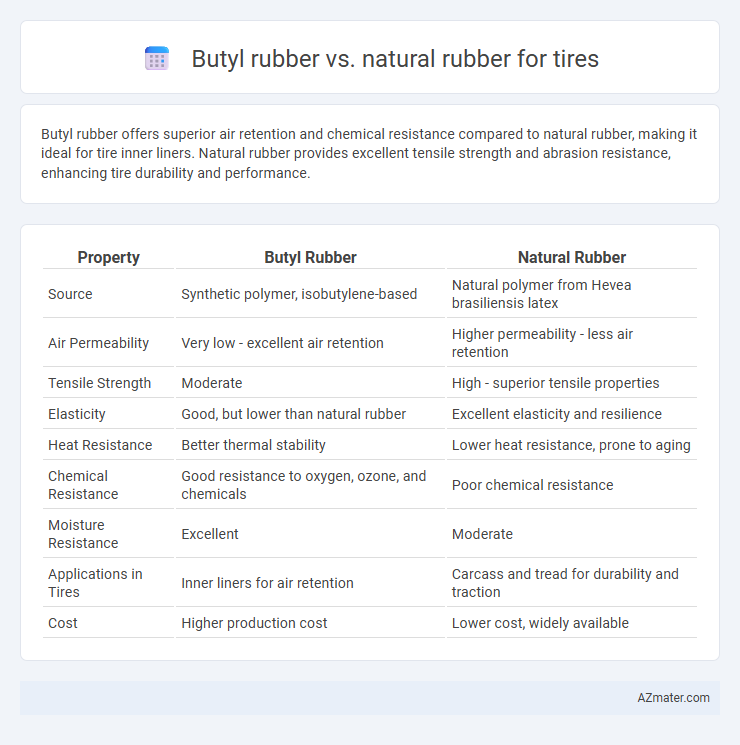Butyl rubber offers superior air retention and chemical resistance compared to natural rubber, making it ideal for tire inner liners. Natural rubber provides excellent tensile strength and abrasion resistance, enhancing tire durability and performance.
Table of Comparison
| Property | Butyl Rubber | Natural Rubber |
|---|---|---|
| Source | Synthetic polymer, isobutylene-based | Natural polymer from Hevea brasiliensis latex |
| Air Permeability | Very low - excellent air retention | Higher permeability - less air retention |
| Tensile Strength | Moderate | High - superior tensile properties |
| Elasticity | Good, but lower than natural rubber | Excellent elasticity and resilience |
| Heat Resistance | Better thermal stability | Lower heat resistance, prone to aging |
| Chemical Resistance | Good resistance to oxygen, ozone, and chemicals | Poor chemical resistance |
| Moisture Resistance | Excellent | Moderate |
| Applications in Tires | Inner liners for air retention | Carcass and tread for durability and traction |
| Cost | Higher production cost | Lower cost, widely available |
Introduction to Butyl Rubber and Natural Rubber
Butyl rubber, a synthetic elastomer composed mainly of isobutylene with small amounts of isoprene, offers superior air impermeability and excellent resistance to heat, chemicals, and aging, making it ideal for tire inner liners. Natural rubber, derived from the latex of Hevea brasiliensis trees, provides exceptional tensile strength, elasticity, and abrasion resistance, which is crucial for tire treads and sidewalls. The combination of butyl rubber's impermeability and aging resistance with natural rubber's strength and flexibility optimizes tire performance and durability.
Chemical Composition and Structure
Butyl rubber consists primarily of isobutylene with a small amount of isoprene, creating a saturated copolymer with excellent impermeability and chemical resistance. Natural rubber is composed mainly of cis-1,4-polyisoprene, featuring a highly elastic, unsaturated hydrocarbon backbone that provides superior tensile strength and flexibility. The saturated backbone in butyl rubber limits oxygen and ozone permeability, whereas the unsaturated structure in natural rubber offers better resilience but is prone to oxidative degradation.
Key Physical Properties Comparison
Butyl rubber exhibits superior air impermeability and excellent resistance to heat, chemicals, and ozone compared to natural rubber, making it ideal for tire inner liners. Natural rubber provides higher tensile strength, greater elasticity, and better abrasion resistance, enhancing overall tire durability and grip on diverse road surfaces. The balance of butyl rubber's impermeability and natural rubber's mechanical robustness determines tire performance quality and lifespan.
Air Retention and Permeability
Butyl rubber exhibits superior air retention compared to natural rubber, making it the preferred material for inner tire linings due to its low permeability to gases such as oxygen and nitrogen. Natural rubber, while offering excellent elasticity and tensile strength, has higher gas permeability, which can lead to faster air loss and reduced tire pressure over time. This difference in permeability significantly impacts tire maintenance intervals and overall lifespan, with butyl rubber providing enhanced durability in maintaining tire inflation.
Heat and Weather Resistance
Butyl rubber demonstrates superior heat and weather resistance compared to natural rubber, making it highly suitable for tire applications exposed to extreme conditions. Its low permeability to air and excellent resistance to ozone, UV rays, and aging contribute to enhanced durability and longer service life. Natural rubber, while offering excellent elasticity and tensile strength, degrades faster under high temperatures and harsh weather, limiting its performance in demanding environments.
Durability and Longevity in Tires
Butyl rubber exhibits superior durability and longevity in tires due to its excellent resistance to ozone, heat, and aging, extending tire lifespan significantly compared to natural rubber. Natural rubber offers high tensile strength and flexibility but tends to degrade faster under harsh environmental conditions, reducing overall tire durability. Tires incorporating butyl rubber compounds maintain air retention and structural integrity longer, making them ideal for long-lasting tire performance.
Performance in Different Driving Conditions
Butyl rubber exhibits superior air retention and resistance to heat and ozone, making it ideal for maintaining tire pressure and durability in high-temperature and prolonged driving conditions. Natural rubber provides excellent flexibility and grip, enhancing traction and performance on wet and slippery roads due to its high resilience and abrasion resistance. Combining both materials in tire construction optimizes overall performance, balancing durability, safety, and driving comfort across diverse environments.
Cost and Manufacturing Considerations
Butyl rubber offers superior air retention and resistance to heat, making it cost-effective for tire inner liners despite higher raw material costs compared to natural rubber. Natural rubber remains less expensive with easier processing but requires additives to improve durability and aging resistance, increasing manufacturing complexity. The balance of cost and manufacturing efficiency often leads to butyl rubber's preference for specialized tire components while natural rubber dominates in tread production.
Environmental Impact and Sustainability
Butyl rubber, derived from synthetic sources, offers superior resistance to air and moisture permeability, contributing to longer tire life and reduced waste compared to natural rubber, which is harvested from rubber trees and is biodegradable but involves deforestation concerns. The production of butyl rubber relies on petrochemical processes that contribute to greenhouse gas emissions, whereas natural rubber cultivation supports carbon sequestration and biodiversity but often involves land use change and water consumption. Sustainability efforts in the tire industry focus on increasing the use of sustainably sourced natural rubber and developing bio-based butyl alternatives to minimize environmental impact while maintaining tire performance.
Choosing the Best Rubber for Tires
Butyl rubber offers superior air retention and excellent resistance to heat, making it ideal for tire inner liners and long-lasting performance. Natural rubber provides outstanding tensile strength, elasticity, and resistance to wear, enhancing tire grip and durability under diverse road conditions. Selecting the best rubber for tires depends on balancing air impermeability with traction needs, often leading manufacturers to use butyl for inner tubes and natural rubber for tread compounds.

Infographic: Butyl rubber vs Natural rubber for Tire
 azmater.com
azmater.com